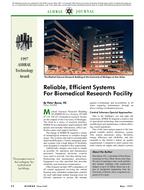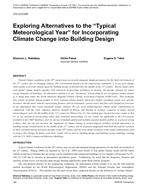Under certain conditions, the migration of small amounts of moisture in the envelope of buildings can cause heat flow through permeable thermal insulation materials due to the conversion of latent heat when moisture evaporates from a warm surface, diffuses through the insulation, and condenses on a colder surface. In these cases, the magnitude of the latent heat flux can be of the same order as heat transfer by conduction. The latent heat transfer may result in a heat gain that coincides with other gains of an occupied building and thus can cause an extra requirement for cooling.
This paper reviews and quantifies the importance of heat flow processes in moist insulation systems. It then employs modeling to analyze the effect of extra heat gain caused by latent heat transfer in the envelope on the thermal load of an office building chosen as an example. An extra cooling requirement of 6% to 7% is found.
Units: Dual
Citation: Symposium, ASHRAE Transactions, 1998, Vol. 104, Part 2, Toronto, ON
Product Details
- Published:
- 1998
- Number of Pages:
- 11
- File Size:
- 1 file , 310 KB
- Product Code(s):
- D-7733


